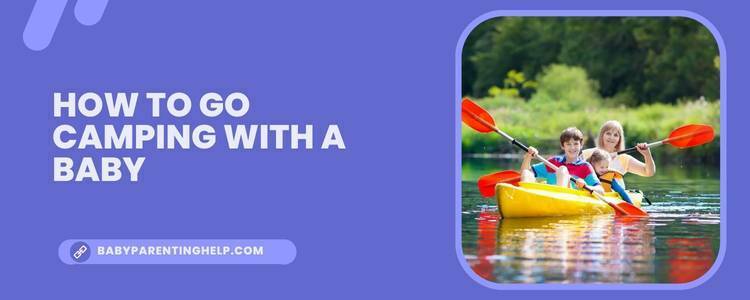As a parent, the idea of going camping with a baby may seem daunting. However, with careful planning and the right mindset, it can be a wonderful way to bond as a family and introduce your little one to the great outdoors. In this guide, we will provide you with everything you need to know about how to go camping with a baby, from preparation and packing to staying safe and comfortable in the wilderness.
Contents
1. Preparing for Your Trip
Before embarking on your camping adventure, it is crucial to prepare adequately to ensure a smooth and enjoyable experience.
A. Assess Your Baby’s Health
Before setting off, make sure your baby is healthy, well-hydrated, and eating normally. Consult with your pediatrician if you have any concerns about your baby’s health or ability to handle the camping environment.
B. Choose the Right Destination
Select a family-friendly campsite that is close to home for your first trip. This will make it easier to retreat if needed and allow you to gain confidence in your new camping routine.
C. Check the Weather
Monitor the weather forecast closely and choose a time with favorable conditions. Avoid camping during extreme temperatures or storms, as this can pose a risk to your baby’s health and safety.
D. Know Your Limits
Be realistic about your expectations and choose a trip that suits your skill level and experience. If you are new to camping, consider starting with a short car camping trip before attempting more challenging wilderness adventures.
2. Packing Essentials
When it comes to packing for a camping trip with a baby, it is important to bring the right gear to ensure your child’s comfort and safety.
A. Clothing
Pack plenty of layers to accommodate changing weather conditions. For colder climates, bring warm clothing, including a hat, mittens, and fleece bunting. For warmer destinations, opt for lightweight clothing to protect your baby’s skin from the sun and insects.
B. Sleeping Gear
Invest in a high-quality sleeping pad or portable crib designed for infants. This will provide a safe and comfortable sleeping environment for your baby during the trip.
C. Diapers and Changing Supplies
Pack plenty of disposable diapers, wipes, and trash bags for easy cleanup. Bring a compact diaper bag for short hikes and a full-size changing pad for use in camp.
D. First Aid Kit
Assemble a basic first aid kit that includes infant Tylenol, a digital thermometer, and any other necessary medications. Familiarize yourself with infant and child CPR, and ensure someone in your group is trained in these lifesaving skills.
3. Setting Up Camp
Upon arrival at your campsite, follow these steps to create a safe and comfortable environment for your baby.
A. Choose a Safe Location
Select a flat, shaded spot for your tent that is free of hazards such as rocks, roots, and insect nests. This will help ensure a safe and comfortable sleeping area for your baby.
B. Set Up a Shelter
Erect a tarp or other shelter to provide shade and protection from the elements. This will create a comfortable area for your baby to rest and play during the day.
C. Create a Diaper Changing Station
Designate an area of your campsite as a diaper changing station, equipped with a changing pad, diapers, wipes, and a trash bag for easy disposal.
4. Feeding Your Baby
Maintaining a consistent feeding schedule while camping is essential for your baby’s well-being and comfort.
A. Breastfeeding
If you are breastfeeding, ensure you have a comfortable chair or pad to sit on while nursing. Stay well-hydrated and pack plenty of nutritious snacks for yourself to maintain your energy levels.
B. Bottle Feeding
If your baby is bottle-fed, bring a double-burner propane stove to heat water for warming bottles. Pack a cooler with ice packs to keep formula and breast milk cold, and bring enough supplies to last the duration of your trip.
C. Introducing Solids
For older babies who have started eating solid foods, pack a variety of easy-to-prepare, nutritious options such as pouches of pureed fruit, vegetables, and grains. Bring a portable high chair for mealtimes and a bib for easy cleanup.
5. Keeping Your Baby Comfortable
Ensuring your baby’s comfort while camping is key to a successful trip.
A. Maintain a Routine
Try to stick to your baby’s usual routine as much as possible, including naps and bedtime. This will help your baby feel more secure and adjust to the new environment.
B. Provide Entertainment
Bring a selection of your baby’s favorite toys and books to keep them entertained and engaged during downtime at camp.
C. Offer Comfort Items
Pack familiar items from home such as a favorite blanket, stuffed animal, or pacifier to help soothe your baby and promote restful sleep.
6. Staying Safe in the Outdoors
While camping with a baby, it is crucial to prioritize safety.
A. Protect Against Insects
Avoid using bug spray on infants younger than two months old. Instead, dress your baby in long sleeves, pants, and socks to protect their skin from bites. Use a mosquito net over their car seat or playpen for added protection.
B. Practice Sun Safety
Avoid using sunscreen on babies under six months of age. Dress your baby in lightweight, protective clothing, and keep them in the shade as much as possible.
C. Monitor Temperature
Regularly check your baby’s temperature to ensure they are not too hot or cold. Adjust their clothing and bedding as needed to maintain a comfortable temperature.
7. Hiking with Your Baby
If you plan to go hiking with your baby, follow these tips to ensure a safe and enjoyable experience.
A. Choose an Appropriate Carrier
Invest in a high-quality, ergonomic baby carrier that provides adequate support for your baby’s head and neck. Make sure the carrier is comfortable for both you and your baby and distributes the weight evenly.
B. Plan Your Route
Select a hiking trail that is suitable for your fitness level and experience. Factor in extra time for breaks and adjust your pace to accommodate your baby’s needs.
C. Stay Hydrated
Bring plenty of water for both yourself and your baby, and take regular breaks to ensure you both stay well-hydrated.
8. Campfire Safety
Campfires are a quintessential part of the camping experience, but they can pose a risk to babies if not managed properly.
A. Establish Boundaries
Create a clear boundary around the campfire area and ensure your baby is always supervised when near the fire.
B. Use a Safe Fire Starter
Avoid using lighter fluid or other accelerants, as they can create unpredictable flare-ups. Opt for a fire starter that is designed for camping use and follow the manufacturer’s instructions.
C. Extinguish the Fire Properly
When it is time to put out the campfire, ensure it is completely extinguished to prevent any accidents. Douse the fire with water, stir the ashes, and douse again until the fire is out and cool to the touch.
9. Leave No Trace
Teach your children the importance of preserving the environment by practicing Leave No Trace principles during your camping trip.
A. Dispose of Waste Properly
Pack out all trash, leftover food, and litter, including used diapers. Use biodegradable soap for washing and dispose of dishwater at least 200 feet away from water sources.
B. Minimize Campfire Impact
Use established fire rings or fire pans, and keep fires small. Burn only small sticks and twigs that can be broken by hand, and avoid burning trash or food.
C. Respect Wildlife
Observe wildlife from a distance and avoid feeding animals. Store food and trash securely to prevent attracting wildlife to your campsite.
10. Embrace the Experience
While camping with a baby may present challenges, it can also be an incredibly rewarding experience.
A. Be Flexible
Accept that your camping trip may not go exactly as planned and be prepared to adapt to your baby’s needs and the conditions you encounter.
B. Cherish the Memories
Embrace the opportunity to create lasting memories with your family and introduce your baby to the wonders of nature.
C. Enjoy the Journey
Remember that children are resilient, and with the right preparation and mindset, camping with a baby can be an enjoyable and fulfilling experience for the whole family.
Conclusion
In conclusion, taking your baby camping may seem overwhelming at first, but with the right preparation, gear, and attitude, it can be a fantastic way to bond as a family and introduce your child to the great outdoors. By following the tips and guidelines provided in this guide, you can ensure a safe, comfortable, and enjoyable camping experience for both you and your baby. So go ahead and embrace the adventure – happy camping!

I am an accomplished writer, a devoted father, and a compassionate advocate for new and experienced parents in my baby’s parenting journey. With a wealth of firsthand experience and a deep understanding of the joys and challenges of raising children, I become a trusted voice in the parenting community.


